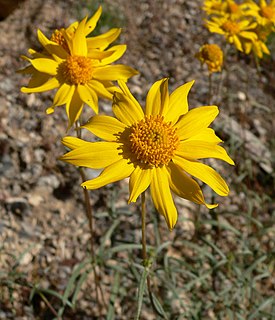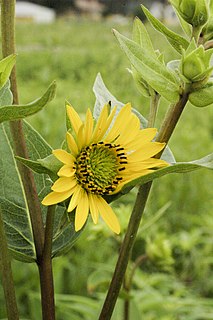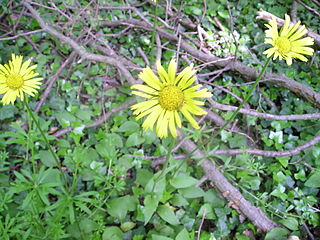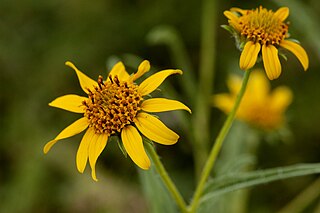
The common sunflower is a large annual forb of the genus Helianthus grown as a crop for its edible oil and edible fruits. This sunflower species is also used as wild bird food, as livestock forage, in some industrial applications, and as an ornamental in domestic gardens. The plant was first domesticated in the Americas. Wild Helianthus annuus is a widely branched annual plant with many flower heads. The domestic sunflower, however, often possesses only a single large inflorescence atop an unbranched stem.

Cornus florida, the flowering dogwood, is a species of flowering tree in the family Cornaceae native to eastern North America and northern Mexico. An endemic population once spanned from southernmost coastal Maine south to northern Florida and west to the Mississippi River. The tree is commonly planted as an ornamental in residential and public areas because of its showy bracts and interesting bark structure.

Helianthus is a genus comprising about 70 species of annual and perennial flowering plants in the daisy family Asteraceae commonly known as sunflowers. Except for three South American species, the species of Helianthus are native to North America and Central America. The best-known species is the common sunflower, whose round flower heads in combination with the ligules look like the Sun. This and other species, notably Jerusalem artichoke, are cultivated in temperate regions and some tropical regions as food crops for humans, cattle, and poultry, and as ornamental plants. The species H. annuus typically grows during the summer and into early fall, with the peak growth season being mid-summer.

Eriophyllum lanatum, with the common names common woolly sunflower and Oregon sunshine, is a common, widespread, North American plant in the family Asteraceae.

Helianthus paradoxus, the paradox sunflower, puzzle sunflower or Pecos sunflower, is a threatened species of sunflower found only in west Texas, Utah, and New Mexico salt marshes by the edges of inland salt lakes and salt flats.

Emilia sonchifolia, also known as lilac tasselflower or cupid's shaving brush, is tropical flowering species of tasselflower in the sunflower family. It is widespread in tropical regions around the world, apparently native to Asia and naturalized in Africa, Australia, the Americas, and various oceanic islands.

Viguiera is a genus of flowering plants in the family Asteraceae. The name honours French physician L. G. Alexandre Viguier (1790–1867). It contains around 150 species, which are commonly known as goldeneyes and are native to the New World. These are herbs to bushy shrubs that bear yellow or orange daisy-like flowers.

Heliomeris is a genus of flowering plants in the family Asteraceae known generally as false goldeneyes.

Emilia fosbergii is a species of plants in the sunflower family. It is commonly known in the United States as Florida tasselflower.

Silphium integrifolium is a species of flowering plant in the family Asteraceae. Its common names include rosinweed, whole-leaf rosinweed, entire-leaf rosinweed, prairie rosinweed, and silflower. It is native to eastern North America, including Ontario in Canada and the eastern and central United States as far west as New Mexico.

Bahiopsis laciniata is a species of flowering plant in the family Asteraceae known by the common names San Diego County sunflower, San Diego viguiera and tornleaf goldeneye. It is native to the deserts and dry mountain slopes of northwestern Mexico, its distribution extending north as far as Ventura County, California.

Bahiopsis reticulata is a species of flowering plant in the family Asteraceae known by the common names netvein goldeneye and Death Valley goldeneye. It is native to the Mojave Desert of California and Nevada, where it grows in several types of dry desert habitat. Many of the populations are inside Death Valley National Park.

Doronicum plantagineum, the plantain-leaved leopard's-bane or plantain false leopardbane, is a European plant species in the sunflower family. It is native to southeastern Europe from Greece and Italy to Ukraine and the Czech Republic. There are reports of the species being naturalized in the State of Oregon in the northwestern United States.
Eucephalus glaucescens is a North American species of flowering plant in the family Asteraceae known by the common name Klickitat aster. It grows on rocky slopes and in subalpine meadows at high elevations on and near Mount Adams in the south-central part of the US State of Washington.
Helianthus carnosus is a rare North American species of sunflower known by the common name lakeside sunflower. It is found only in the northeastern part of the state of Florida in the United States.
Helenium apterum is a North American perennial plant in the sunflower family. It has been found only in the state of Durango in northwestern Mexico. Turner, B. L. 2013. The comps of Mexico. A systematic account of the family Asteraceae. Phytologia Memoirs 16: 1–100

Heliomeris hispida is a North American species of flowering plants in the family Asteraceae called the hairy goldeneye or rough false goldeneye. It is native to the southwestern United States and also to the northern Sierra Madre Occidental of western Chihuahua and eastern Sonora in Mexico. There are a few reports of the species growing in California, but these are most likely introduced populations.
Heliomeris longifolia is a North American species of flowering plants in the family Asteraceae called the longleaf false goldeneye. It is widespread across much of Mexico from Chihuahua and Sonora south to Chiapas, and found also in the southwestern United States from Nevada to western Texas.

Heliomeris multiflora is a North American species of flowering plants in the family Asteraceae called the showy goldeneye. It grows in Mexico and the western United States from Montana to Jalisco.
Heliomeris obscura is a rare Mexican species of flowering plants in the family Asteraceae. It has been found only in a remote area of dry shrublands in eastern Mexico, in the states of Puebla and Veracruz.













